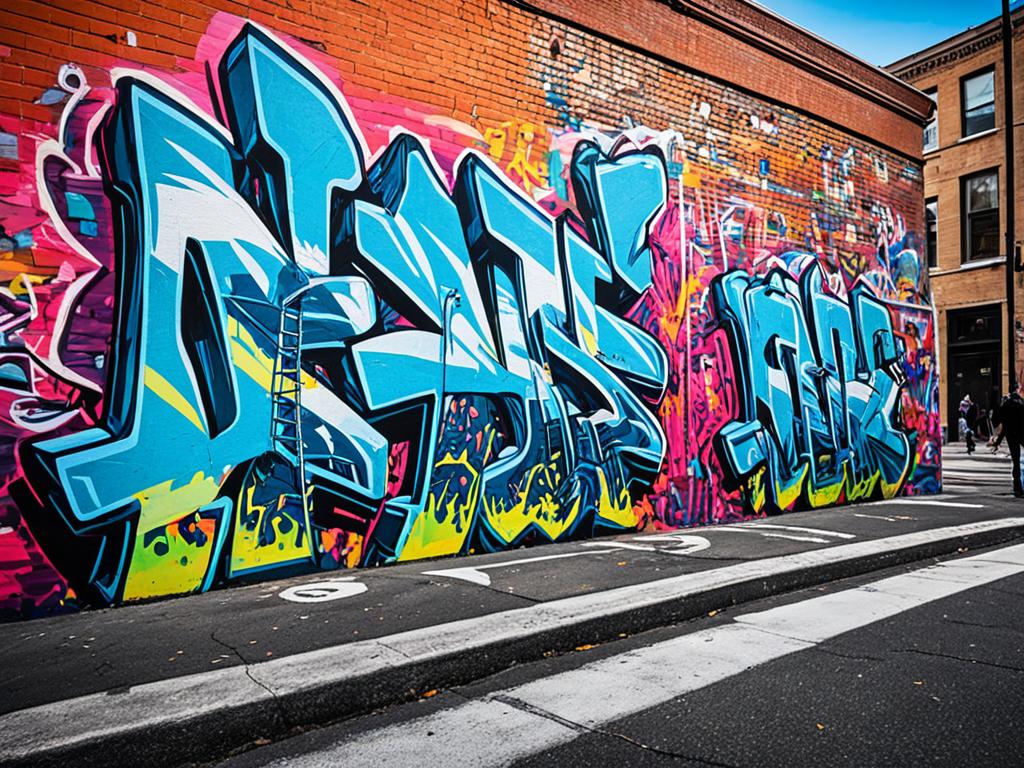Welcome to the vibrant world of street art, where the walls of our cities transform into captivating canvases that speak volumes. From small-scale graffiti to powerful public statements, street art has become a global phenomenon, capturing the imagination of artists, locals, and tourists alike. In this article, we will delve into the evolution of street art and explore its significance as a platform for creative expression and social commentary.
Street art, often mistaken for graffiti, is more than just an act of vandalism. It has emerged as a powerful medium through which artists can communicate their messages to the public. What once were mere city walls are now arenas for thought-provoking art that tackles important societal issues. From political movements to cultural revolutions, street art has the ability to challenge norms and raise awareness in a way that no other art form can.
Throughout history, street art has evolved from its origins in graffiti, gaining recognition and legitimacy as a unique form of artistic expression. Today, renowned street artists like Banksy and Shepard Fairey have elevated the genre to new heights, captivating audiences with their thought-provoking creations. With bold colors, intricate details, and imaginative designs, these artists breathe life into the concrete jungles we call cities.
Street art isn’t just about aesthetics; it has the power to voice the concerns of the voiceless. From championing human rights to advocating for environmental conservation, artists have used their talents to give marginalized communities a platform to be heard. Through their work, they shed light on social injustices, sparking conversations and inspiring change.
However, the legal landscape surrounding street art remains a complex issue. Artists must navigate the fine line between artistic expression and vandalism, often facing legal challenges in their quest to beautify our urban environments. The transient nature of street art adds another layer of complexity, as these masterpieces can disappear as quickly as they appeared, leaving behind only memories and photographs.
In conclusion, street art has become more than just a visual treat. It has evolved into a powerful movement that speaks volumes about our society, its values, and its challenges. The city walls have become the canvas, and the streets the gallery, where artists can express themselves freely and leave a lasting impact on our collective consciousness.
Key Takeaways:
- Street art is not just graffiti; it is a legitimate form of artistic expression.
- Street art has the power to raise awareness, challenge norms, and advocate for social change.
- Renowned street artists like Banksy and Shepard Fairey have elevated the genre to new heights.
- Street art acts as a voice for the voiceless, highlighting the concerns of marginalized communities.
- The legal landscape surrounding street art is complex, with artists facing challenges in finding legal walls and navigating legal boundaries.
A Brief History of Street Art
Street art has a rich and captivating history, evolving from its humble beginnings within the graffiti subculture to becoming a prominent form of artistic expression in the urban landscape. This section will take you on a journey through the key moments and influential artists that have shaped the street art movement over time.
The origins of street art can be traced back to the graffiti subculture that emerged in the 1970s in New York City. Graffiti artists, armed with spray cans, began leaving their marks on public spaces, using the city walls as their canvas to express their creativity and leave a lasting impression. This underground art form quickly gained momentum and became a powerful visual language reflecting the social and cultural context of the urban environment.
“Art is not limited to the confines of galleries and museums. It is a reflection of society and should be accessible to all.” – Jean-Michel Basquiat
In the 1980s, influential artists like Jean-Michel Basquiat and Keith Haring elevated street art to new heights, breaking barriers and blurring the lines between fine art and graffiti. Basquiat’s bold and expressive style merged powerful symbolism with social commentary, while Haring’s iconic figures and vibrant colors conveyed messages of love, unity, and activism.
As the street art movement gained momentum, artists across the world began embracing the power of public spaces to share their artistic visions. From the political murals in Northern Ireland to the playful creations in the streets of São Paulo, street art became a platform for cultural expression, challenging societal norms, and initiating conversations.
One of the defining moments in street art history occurred in the early 2000s when elusive guerrilla artist Banksy emerged onto the scene. His thought-provoking and often controversial works captivated global attention, pushing the boundaries of what street art could achieve and sparking renewed interest in the genre.
Throughout history, street art has continuously evolved, pushing boundaries, and challenging conventions. From vibrant murals to subtle stencils, artists have harnessed the power of the streets to make bold statements and ignite change. Today, street art can be found in cities across the globe, creating an open-air gallery that reflects the pulse of urban life.
Graffiti vs. Street Art: Understanding the Distinctions
When it comes to urban art, the terms “graffiti” and “street art” are often used interchangeably, but they actually represent distinct forms of artistic expression. Understanding the differences between graffiti and street art is crucial to appreciate the unique characteristics and motivations behind each.
Graffiti can be traced back to the early days of urban culture, where it emerged as an illicit art form associated with rebellion and underground movements. Often considered a form of vandalism, graffiti is typically characterized by bold lettering, vibrant colors, and an emphasis on individual style. It is driven by personal expression, sometimes with political or social undertones, and encompasses a wide range of techniques, from spray paint to markers.
On the other hand, street art has evolved from its graffiti origins to encompass a more holistic approach to artistic expression in public spaces. Street artists often use various mediums, including stencils, wheatpaste, and murals, to create visually striking works that provoke thought, convey messages, and challenge societal norms. Street art goes beyond mere decoration; it aims to transform urban landscapes into open-air galleries that engage with the surrounding environment.
What sets street art apart is the intention behind it. While graffiti may focus on self-expression or territorial marking, street art aims to engage and involve the community, encouraging dialogue and promoting social change. Street artists seek to challenge the status quo, elevate public spaces, and bring art to unexpected locations. With its blend of aesthetics and activism, street art has gained recognition and respect as a legitimate art form.
The Contrasting Motivations and Techniques
One of the key distinctions between graffiti and street art lies in their underlying motivations. Graffiti often emerges from a sense of rebellion or defiance, rooted in alternative narratives and counterculture movements. Whether it’s an act of personal expression or a form of protest against societal norms, graffiti usually challenges the authority of public spaces.
Street art, on the other hand, is driven by a desire to beautify and engage with the community. It aims to create a dialogue within the urban environment, forging connections between the artwork and the audience. Street artists carefully choose their subjects and locations, often addressing social and political issues or using their art as a powerful tool for storytelling and cultural commentary.
Techniques also play a role in distinguishing graffiti from street art. Graffiti artists typically focus on lettering and tags, drawing attention to their signature styles through intricate designs and vibrant colors. Their work is often spontaneous and executed quickly, reflecting the fleeting nature of graffiti as an underground art form.
Street artists, on the other hand, employ diverse techniques, adapting their artistic skills to create large-scale murals, intricate stencil designs, paste-ups, and other inventive approaches. They invest significant time and effort in planning and executing their works, often collaborating with communities or local authorities to ensure their art aligns with the spirit of the place.
Societal Perception: From Vandalism to Art
The societal perception of graffiti and street art has evolved significantly over time. While graffiti was historically seen as an act of vandalism or a form of urban blight, street art has gradually shifted that perception, gaining recognition as a legitimate art form that contributes to the cultural fabric of our cities.
Street art has transcended its rebellious origins and entered the realm of cultural appreciation and acceptance. It has become a way to revitalize neglected neighborhoods, promote dialogue, and challenge preconceived notions about art and public spaces.
This shift in perception can be attributed to several factors. Firstly, the intricate and thought-provoking nature of street art has garnered attention from art enthusiasts and collectors, blurring the lines between street art and traditional gallery-based art. Moreover, city officials and local governments have recognized the positive impact of street art in attracting tourists and fostering artistic communities.
As street art gains acceptance, there is an increasing effort to distinguish it from graffiti and develop legal avenues for artists to display their work. Cities around the world now host street art festivals, commission public art projects, and designate legal walls to provide street artists with opportunities to showcase their talent within a regulated framework.
Overall, understanding the distinctions between graffiti and street art is essential for appreciating the unique qualities and intentions behind each artistic form. While graffiti represents rebellion and personal expression, street art transforms public spaces into vibrant galleries that engage with communities and spark conversations about art, culture, and social issues.
| Graffiti | Street Art |
|---|---|
| Associated with rebellion and counterculture | Driven by a desire to beautify and engage the community |
| Focuses on individual style and bold lettering | Uses diverse techniques and engages with larger themes |
| Often perceived as vandalism | Gaining recognition as a legitimate art form |
| Motivated by self-expression and territorial marking | Aims to challenge norms and promote social change |
Public Statements: Art as a Voice for the Voiceless
Street art has evolved beyond mere aesthetics and self-expression. It has become a powerful platform for public statements, giving voice to the voiceless and shedding light on important social and political issues. In cities around the world, vibrant murals and thought-provoking graffiti serve as visual protests, sparking conversations and drawing attention to marginalized communities.
By using the city walls as their canvas, street artists have found a way to bypass traditional channels of communication and make their message impossible to ignore. Through bold imagery and powerful symbolism, they challenge societal norms, question authority, and advocate for change. From advocating for racial justice to raising awareness about environmental degradation, street art serves as a visual representation of the collective conscience of a community.
One notable example of street art as a public statement is the work of Banksy. This anonymous British artist has gained international recognition for his politically charged and socially provocative murals. His stenciled artworks depict powerful messages about war, capitalism, and inequality, offering a poignant commentary on the world we live in. Banksy’s pieces have sparked global discussions and inspired a new generation of street artists to use their art to address pressing issues.
Another renowned street artist, Shepard Fairey, is known for his iconic “Hope” poster featuring Barack Obama during the 2008 presidential campaign. This image became a symbol of inspiration and empowerment, capturing the spirit of change and unity. Fairey’s art has since expanded to encompass a range of social and political topics, including racial equality and climate change.
“To be able to take art that really represents the voice of the people — political art, social justice art – and put it out there where everybody can see it and enjoy it, that’s for me the ultimate in street art.” – Shepard Fairey
The power of street art lies not only in its ability to convey messages but also in its accessibility. Unlike art confined within gallery walls, street art reaches a wider audience, including those who may not typically engage with the art world. It brings art directly into the public sphere, igniting conversations, and challenging passersby to question the status quo.
Raise Awareness and Inspire Change
Through its visual impact and inherent subversiveness, street art has the power to raise awareness and inspire tangible change. It serves as a reminder that art can transcend the confines of galleries and museums, creating a democratic space for public dialogue and engagement. Whether it’s addressing issues of social justice, human rights, or environmental sustainability, street art continues to be a vital tool for speaking out against injustice and amplifying the voices of the voiceless.
The Legal Landscape: Street Art
When it comes to street art, navigating the legal landscape can be a complex and challenging endeavor. Artists who choose to paint city walls and public spaces often find themselves grappling with the question of legality and the obstacles they must overcome to share their creativity with the world.
One of the primary challenges faced by street artists is finding legal walls or obtaining permission for their work. The traditional notion of graffiti as vandalism has led to strict regulations and restrictions imposed by local authorities. Street artists must search for designated areas or collaborate with property owners to secure the necessary permits, turning the artistic process into a negotiation with the legal system.
However, even with permission, the ephemeral nature of street art poses its own legal dilemmas. While regulations may allow artwork to grace the walls of a city for a limited time, the transient nature of these pieces raises questions about preservation and artistic freedom. Street art is often subjected to removal, eradication, or even alteration by local authorities or other individuals, blurring the line between vandalism and cultural significance.
Furthermore, the tension between preserving street art as cultural heritage and enforcing property rights adds to the intricacy of the legal landscape. The unauthorized appropriation of street art has led to conflicts between artists, collectors, and government agencies. These disputes highlight the need to find a delicate balance between protecting the artistic expression while respecting the rights of property owners.
| Legal Challenges | Impact |
|---|---|
| Lack of designated legal walls | Restricts creative expression |
| Ephemeral nature of street art | Raises questions about preservation and artistic freedom |
| Tension between preservation and property rights | Conflicts between artists, collectors, and government agencies |
Despite these challenges, street art continues to thrive as a powerful means of expression and public engagement. Emerging legal frameworks and initiatives that recognize the cultural value of street art aim to strike a balance between public interest, artistic integrity, and property rights. However, the legal landscape surrounding street art remains complex and subject to ongoing debates and discussions.
Seeking Legal Walls: A Safe Haven for Street Artists
A glimmer of hope for street artists lies in the growing acceptance and establishment of legal walls. These designated spaces provide artists with the opportunity to create artwork without the fear of legal repercussions. The existence of legal walls not only supports the artistic community but also contributes to beautifying neighborhoods and establishing a sense of cultural identity.
Preservation vs. Authenticity: The Dilemma of Street Art
The tension between preserving street art as a cultural heritage and the temporary nature of the medium raises important questions surrounding authenticity. While some argue for the preservation of significant pieces, others believe that the very ephemeral nature of street art is what gives it its power and impact. Balancing the desire to immortalize street art and the artist’s intended impermanence is a complex challenge that continues to shape the legal landscape.
Conclusion
In conclusion, the street art phenomena has emerged as a powerful form of artistic expression and public engagement. From its humble origins as graffiti, street art has transcended societal perception to become a platform for making public statements and igniting conversations.
Throughout history, street art has evolved, drawing inspiration from various artistic movements and cultural influences. Today, it stands as a vibrant and dynamic art form, showcasing the diversity and creativity of artists who utilize city walls as their canvas.
But street art is more than just paint on walls. It has the unique ability to give voice to the voiceless, shedding light on social and political issues that impact our communities. It challenges the status quo, provokes thought, and sparks meaningful dialogues among individuals.
As we navigate the legal landscape surrounding street art, it is crucial to strike a balance between preserving artistic freedom and respecting property rights. By understanding its distinction from graffiti and acknowledging its role as a legitimate art form, society can fully appreciate the impact and significance of street art.
Street art has the power to transform not only physical spaces but also minds and hearts. It has the potential to inspire, uplift, and shape the identity of a city. So let us embrace the endless possibilities that city walls hold, recognizing street art as a catalyst for change, a celebration of creativity, and a reflection of the vibrant communities we live in.







